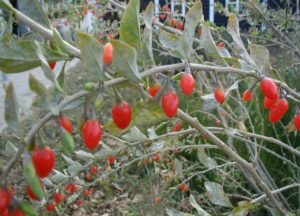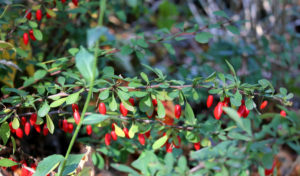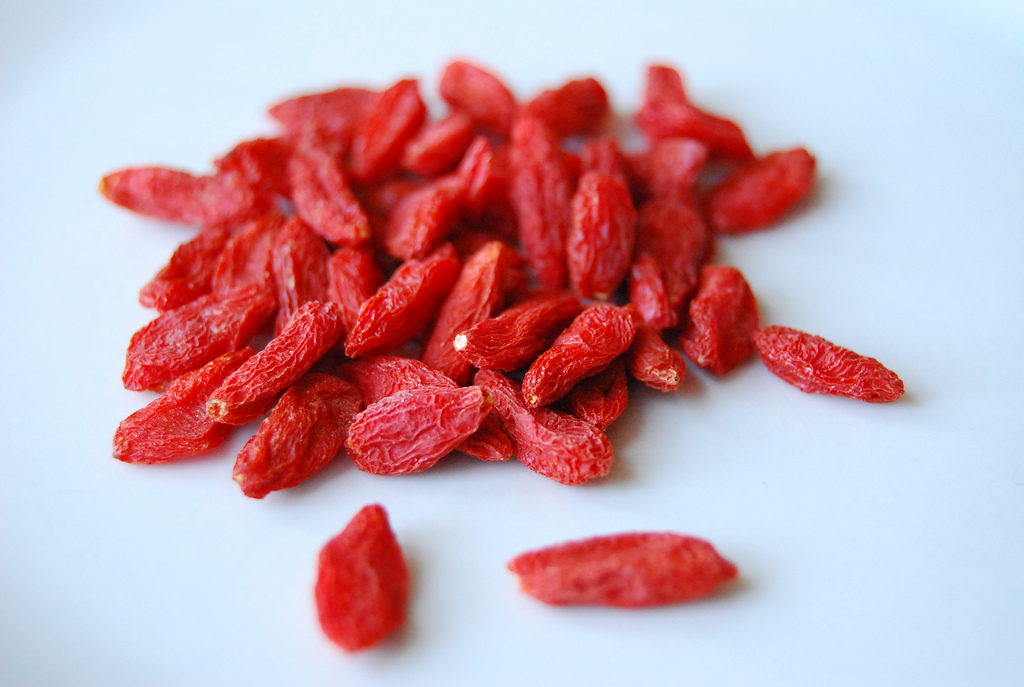Goji berries, or wolfberries, are the fruit of either the Lycium barbarum or Lycium chinense, two closely related species of boxthorn in the nightshade family, Solanaceae. The two species are native to Asia. Take a look below for 24 more interesting and fascinating facts about goji berries.
1. Goji berries are deciduous woody perennial plants that grow between 1 and 3 meters high.
2. Lycium chinense are grown in the south of China and tend to be somewhat shorter, while Lycium barbarum are grown in the north, primarily in the Ningxia Hui Autonomous Region, and they tend to be somewhat taller.
3. Goji berry leaves form on the shoot either in an alternating arrangement or in bundles of up to 3, each having either a lanceolate, meaning that it’s shape liked a spearhead longer than it is wide, or ovate, meaning egg-like, shape.
4. Goji berry leaf dimensions are 7 centimeters, or 2.8 inches, long by 3.5 centimeters, or 1.4 inches, broad with blunted or rounded tips.

5. The Goji berry flowers grow in groups of 1 to 3 in the leaf axils. The calyx, which is eventually ruptured by the growing berry, consists of bell-shaped or tubular sepals forming short, triangular lobes.
6. In the Northern Hemisphere, goji berry flowering occurs from June through September and berry maturation occurs from August to October, depending on the altitude and climate.
7. Lycium, the genus name, comes from the ancient southern Anatolian region of Lycia. The fruit is known in pharmacological references as Lycii fructus, which is Latin for “Lycium fruit.”
8. “Wolfberry”, the commonly used English name for goji berries, has unknown origin but perhaps it comes from the genus name, Lycium, closely resembling “lycos”, the Greek word for wold.
9. In the English-speaking world, the name “goji berry” has been used starting around 2000.
10. Since the early 21st century, interest has increased in goji berries for their novelty and supposed nutrient value.

11. In traditional medicine, goji berries or its extracts are said to have numerous implied health effects, which remain scientifically unconfirmed as of 2014.
12. Goji berries have a natural tinge of sweetness with a very slight herb like aftertaste. They also contain tiny seeds, which contain fiber, that add a nice texture to your meals.
13. You can eat goji berries raw or soak them in hot water beforehand. Some people prefer adding goji berries to trail mixes, smoothies or as a garnish on cereals, salads or yogurts.
14. Similar to the benefits you get from eating other berries, goji berries are full of beta-carotene, which is a pigment found in plants and fruits, which help promote healthy skin.
15. Goji berries have been known to help boost the immune system and protect the eyes. Like other berries, they’re also an excellent source of vitamin C.
16. Goji berries have a long history tied to sexual fertility. One study in rats showed that goji berries significantly increased sperm quantity and movement, shortened erection, capture and ejaculation response, improved sexual ability and improved recovery of testosterone levels.

17. The majority of commercially produced goji comes from Ningxia and Xinjiang in Northwestern China, where they are grown on plantations totaling 200,000 acres.
18. In Zhongning County, Ningxia, goji berry plantations typically range between 40 and 400 hectares, which is 100 to 1000 acres, in area.
19. Goji berries are celebrated each August in Ningxia with an annual festival coinciding with the berry harvest. Originally held in Ningxia’s capital, Yinchuan, the festival has been based since 2000 in Zhongning County.
20. On June 18th, 2009, the U.K. Food Standards Agency stated that a significant history exists of goji berries being consumed in Europe before 1997, and has removed it from the Novel Foods list.
21. During the first decade of the 21st century, farmers in Canada and the United States began cultivating goji berries on a commercial scale to meet potential markets for fresh berries, juice and processed products.

22. Potentially harmful interactions can occur if goji berry is eaten while taking other medications, such as those metabolized by the cytochrome P450 liver enzymes.
23. Companies marketing goji berries often propagate the unsupported claim that a Chinese man named Li Qing Yuen, who was said to have eaten goji berries daily, lived to the age of 256.
24. Various wines containing goji berries are produced, including some that are a blend of grape wine and goji berries.




